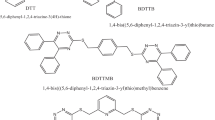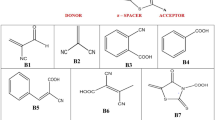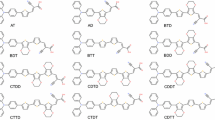Abstract
The vibrational frequencies obtained by the recorded the spectra of FT-IR and FT-Raman are precisely assigned and compared with the theoretical frequencies. The stabilities of p-hydroxybenzoylhydrazine (HBH) and p-aminobenzoylhydrazide(ABH) are analyzed through PES scan, and most stable structures are obtained. On the most stable structures of these two compounds, the HOMO–LUMO analysis is carried out at B3LYP/6-31G (d,p) level for the zero field and with fields (0.015 and 0.025 VA−1). The HOMO–LUMO gap widely decreases from 4.0592 eV to 0.6323 eV and 3.7645 eV to 0.4040 eV, respectively, as the field increases (0.0—0.025 VA−1). The HOMO–LUMO gap is also measured from the DOS spectrum which is also in line along with the calculated value using the Gaussian 09 W program package. The DOS spectrum predicts that the HOMO–LUMO gap decreases when there is the increase in the electric field. The donors studied theoretically in this study are azulene, pyrrole, furan, tetrafuran and thiophene. The global reactivity descriptors, i.e., ionization potential (IP), hardness (η), chemical potential (μ), electron affinity (EA), softness (s), electronegativity (χ), electrophilicity index (ω), maximum amount of electronic charge (∆Nmax), nucleofugality (∆En), electrofugality (∆Ee) and ΔEback-donation are calculated for all hydrazide derivatives. The best dye sensitized solar cell (DSSC) performance is observed in HBH and ABH derivatives with thiophene donor group compared to other donor groups.















Similar content being viewed by others
References
K. Sharma, V. Sharma, S.S. Sharma, Nanoscale. Res. Lett 13(1), 381 (2018)
A. Hema Chander, M. Krishna, Y. Srikanth, IOSR. J. Electr Electron. Eng. 10, 151–154 (2015)
M.E.M. Zayed et al., Chem. Cent. J 12, 26 (2018)
K. Galappaththi, Int. J. Photoenergy. Volume 2017, Article ID 8564293
F. Zanjanchi, J. Beheshtian, J. Iranian. Chem. Soc 16(4), 795–805 (2018)
M.J. Frisch, G.W. Trucks, H.B. Schlegal et al.,GAUSSIAN 09, Revision A.02,Gaussian, Inc., Wallingford CT, (2009)
L. Wen, H. Yin, W. Li, K. Li, Acta. Cryst. E 65, o2623 (2009)
L.J. Bellamy, Polymer Letters Edition, 3rd edn. (Wiley, New York, 1975), pp. 121–121
V. Arjunan, S. Mohan, S. Subramanian, B.T. Gowda, Spectrochim. Acta. A. 60(5), 1141–1159 (2004)
G. Varsanyi, vol. I, Adam Hilger, London, 1974.
D.L. Pavia, G.M. Lampman, G.S. Kriz (eds.), Brooks/Cole (Thomson Learning, Singapore, 2001), p. 52
V. Arjunan et al., Spectrochim. Acta. Part A 79, 486–496 (2011)
H. Lampert, W. Mikenda, A. Karpten, J. Phys. Chem. 101, 2254–2263 (1997)
M. Snehalatha, C. Ravikumar, I. Hubert Joe, V.S. Jayakumar, J Raman Spectrosc. 40(9), 1121-1126 (2009)
H.O. Kalinowski, S. Berger, S. Braun, John Wiley & Sons, Chichester, 1988.
K. Pihlaja, E. Kleinpeter (Eds.), VCH Publishers, Deerfield Beach, 1994.
V. Vimalraj et al., Spectrochim. Acta Part A 78, 670–675 (2011)
R. Zaleśny et al., THEOCHEM 907, 46 (2009)
R.G. Pearson, J. Chem. Sci. 117, 369–377 (2005)
G.C. dos Santos et al., J. Mol. Modeling 25, 75 (2019)
F. Barati-darband et al., J. Phys. Chem. C 122, 23968–23977 (2018)
Funding
R.M (R. MEENAKSHI) thanks the University Grants Commission (UGC) for the fund provided for the minor research project (MRP-7006/16(SERO/UGC).
Author information
Authors and Affiliations
Corresponding author
Ethics declarations
Conflict of interest
The author declare that they have no conflict of interest.
Electronic supplementary material
Below is the link to the electronic supplementary material.
Rights and permissions
About this article
Cite this article
Meenakshi, R. FT-IR and FT-RAMAN analysis and light-harvesting efficiency (LHE) enhancement for DSSC applications of hydrazide derivatives. J IRAN CHEM SOC 18, 1179–1198 (2021). https://doi.org/10.1007/s13738-020-02101-y
Received:
Accepted:
Published:
Issue Date:
DOI: https://doi.org/10.1007/s13738-020-02101-y




